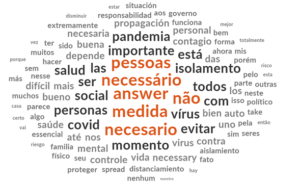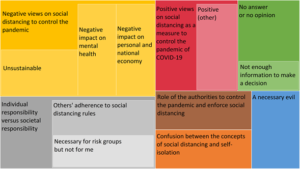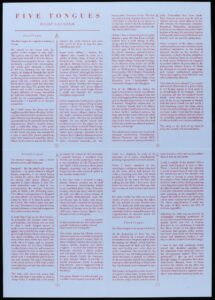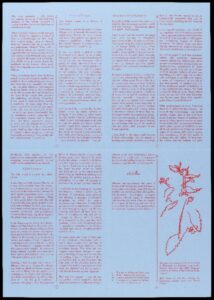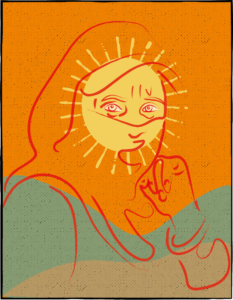This article has been published in the Special Issue “COVID-19 and the Transformation of Intimacy” in Anthropology in Action 27(3):18-21 (December 2020).
‘The main impact is that everybody’s always here with me! Including my ex-husband to be’, Jenny said with a wry chuckle. She was sitting on a grey sofa in her living room in central Scotland, though I could only see a corner of it via Skype. She explained that she and her husband were separating, but that he had had to delay moving out because of the lockdown. When the schools closed, just a week before our interview, they found themselves stuck in the house together with their two school-age children and very little space and time to be apart.
On 20 March 2020, nurseries and schools were closed across the United Kingdom in response to the growing threat of COVID-19. Families like Jenny’s were left scrambling to sort out care for their kids, bracing themselves for major changes in their working lives and trying to prepare their households to face a disease no-one understood. Three days later, on 23 March, Prime Minister Boris Johnson declared a national lockdown and instructed the people of the United Kingdom to stay at home to stop the disease spreading between households.
On the same day the United Kingdom closed its schools, the World Health Organization advocated reframing the prevalent public health strategy of social distancing as ‘physical distancing’, in order to highlight the risk of social isolation (WHO 2020). ‘Social distancing’ nonetheless remains the term most used in the media and by the public to describe current public health measures, from working at home to ensuring a two-metre distance between members of different households. But what the catch-phrase misses is a crucial dimension of the lived experience of the pandemic: an unprecedented degree of inescapable proximity within households and the imperatives of finding new ways to manage space, time, selves and relationships.
In the first two weeks after school closures, we conducted semi-structured, remote interviews with ten mothers of children in nursery and in primary school. They were contacted through randomly selected council nurseries in central Scotland. We sought initial insight into the experiences of parents with young children and the ways they were navigating the sudden, drastic readjustments required by lockdown.
While important research has drawn attention to the threats of increased domestic violence under lockdown (Campbell 2020; Usher et al. 2020), our study considers subtler shifts in family dynamics in response to the new pressures of ‘pandemic proximity’. It provides an early insight on how mothers handle the forced intimacies of family life under lockdown through the experimental management of space and time. The result is a more expansive understanding of the family in contemporary Scotland and a notion of intimacy characterised as much by distance and distinction as by proximity and mutuality.
Pandemic Proximity
The closure of schools and workplaces, but also cafés, non-essential shops, and public gathering places, created a sudden, acute pressure on households to reconfigure their ways of living together. For the mothers we spoke to, being ‘stuck home together’ offered the welcome prospect of more time with their kids, but it also provoked unexpected anxieties. Natalie is a full-time lawyer and single mother living in a ‘smallish’ house with her three young children, who are aged between one and six years old:
It’s basically total chaos [child screams in the background] with the workload during the week. . . . I am just trying to do my job at home with the kids around which I think is actually just impossible. Or it’s not possible to do it the same way, because as soon as you sit down to do anything, somebody gets hurt. . . . Yeah and you feel like you are just not good at doing a good job at any of them because, you know, firing out e-mails and then running away and just going from thing to thing. . .
Natalie was perhaps the most overwhelmed of our respondents, but her concerns echoed those of other women we interviewed. Sonia, an NHS (National Health Service) surgeon with two primary school-age children, also anticipated school closures would create a ‘nightmare’ at home. She would continue working in the hospital during the lockdown and expected stressful times ahead: ‘When the children are at school and I have time for myself, I just find that it is such a recharge space. . . . I am pretty anxious about not having that anymore and always having people here’.
If the space of the house did not feel overcrowded, time did. The sudden necessity of reorganising daily routines, and relationships in turn, was a particular source of unease. As Annie, who worked part-time in a grocery shop, put it: ‘Now the whole dynamic in the home has completely changed. Me and [my son] had a very strict routine, and now that’s kind of gone out the window. I relied on that routine as my job, as being a mum, and now I feel this disconnect. Me and my partner don’t know how to parent at the same time’.
From a public health perspective, households are key sites of potential contagion, as well as natural units of care. This assessment is based in part on the assumption that households are generally self-sufficient families, and that the two categories neatly overlap. Separating households was therefore a crucial tactic in preventing the spread of the virus and in providing in-built support for those who might fall ill at home.
Most of the mothers we interviewed worked to frame their homes as ‘safe spaces’ protected from the contaminated outside world, rather than as spaces of risk. Annie, for example, found it stressful to follow social-distancing rules at the grocery shop, but at home she felt safe:
I feel safe when I’m at home, because my partner doesn’t leave the house and neither does [my son]. Well, they do, they go out and go for walks . . . we make sure he doesn’t touch anything metal, or anything that has been known to harbour the virus . . . He wears gloves and then, when they come in, we take the gloves off – when we’re in the porch, we take them off. So, they are kind of clean, so when I am around them, I feel clean.
Keeping the home a safe space, as Annie’s description implies, involved reinforcing and sanitising its boundaries. Crossing those boundaries – stepping over the threshold – was risky and needed to be carefully managed. Nina, a university employee who lived in a flat with her husband and three-year-old son, described a new habit of putting her ear to the door before stepping outside to make sure that her neighbours were not in the staircase.
At the same time, making the house a safe space highlighted and intensified its intimacies and the risks they presented. The women we spoke with were confined not only with children and spouses, but with partners from whom they were separating and could not be separated. And in some cases, the intensity of these intimacies took on a sharply physiological quality. Janet, who lived with her husband and their three sons, described the impracticability of self-isolation in case one of them developed symptoms. She could not physically separate from her breastfeeding baby, nor could she ensure the single shared bathroom would be wiped down after each use. Her family’s physical proximity under lockdown, combined with the contagiousness of COVID-19, had morphed them into a unit of shared risk, akin to sharing a body; if one of them developed symptoms, all would have to ‘self-isolate together’, as Janet put it.
The boundaries of the household, then, were clarified and reinforced during lockdown. But their clarification also highlighted something unexpected: the fact that the household not only relied on a wide range of other social actors and community institutions in its everyday operations, but that the experience of family – especially as a network of care – was lived and mediated through relationships with those actors and institutions. All our interviewees described being cut off from these relationships as a major impact of the lockdown. As Natalie noted: ‘We had nursery, we had a playgroup . . . and we had a childminder, and we had school, and we had my parents helping out’. At the same time, no fewer than three of our ten respondents were undergoing divorces that were put on hold by the lockdown. The boundaries of the household, in other words, proved not to overlap with the lived experience of family in the way public health interventions assumed. Under lockdown, the ‘nuclear’ family became suddenly ‘unclear’ (Simpson 1994).
Intimate Distinctions
‘I now have to be mother, teacher, and civil servant at the same time!’ Helena exclaimed, sounding exhausted. The wife of a key worker, Helena suddenly found herself looking after her two-year-old and a seven-year-old alone, while working as senior manager. To top it off, most of the house was in boxes, in anticipation of a move now indefinitely postponed. But as befits an experienced manager, Helena had a plan. The boxes made space trickier to manage, but she could still manage routines – and time. After establishing a schedule for the children, she organised her working hours into the gaps that remained, writing emails early in the morning and late at night when the children slept, or after lunch while the toddler napped and the older boy read. Still, the concentration of her responsibilities in a single location and all ‘at the same time’, without the usual support of the children’s father, grandparents and teachers, stretched her ability to cope. ‘It’s just not sustainable’, Helena said.
In other cases, the loss of work or schooling suspended usual schedules and routines. Sarah was a single mother of two boys, who were nine and seven years old. She was a university student, and her final exams had been cancelled. As she said:
Half of me is like ‘yeah! I don’t need to do anything. I got like six months off’. The other part of me is ‘Oh my God, I’m gonna be so bored’. . . . The first couple of days, right, the kids played on the computer, I watched TV, we tidied up, cooked a bit and cleaned a bit, and now it’s like, ok it’s been a week and I need to do something.
As the boundaries of the household solidified, boundaries within the household around space, time, roles and responsibilities were unsettled or broke down – and mothers working at home discovered a need for new distinctions to sustain a sense of self. While Helena’s multiple roles as mother, teacher and civil servant were dispersed over different places and times, they were manageable; but conflated in the same space and time, they quickly became unsustainable. Conversely, as Sarah’s studies were put on pause, she needed to carve out new ways of being in the confined space-time of home. For these mothers, the creation of spatial and temporal boundaries between work, study, childcare and leisure time became crucial, if difficult, to maintain, especially when toddlers walked into home offices during online meetings or colleagues sent messages during story time.
While Helena created distinctions around the children’s schedules, Nina took a different tack. Nina worked from a home office in her two-bedroom flat and described being ‘terrified’ of having to manage full-time work alongside childcare. But as the lockdown progressed, Nina and her husband made a point of splitting the day and the flat in half, creating space and time to be apart, which helped them to reconnect. ‘So far, we are sharing half time every day, with childcare’, she explained. ‘Even if we don’t go to work, we still have a half day for ourselves. . . . Just not to see each other’s face. So, we almost miss each other at the end of the day’.
In his work on the relationship between self and identity in Pakistan, Martin Sökefeld (1999) notes that people may perform different – even contradictory – identities depending on social context, and that their ideas of self rely on movement between these identities in everyday life. Our study indicates that, when usually distinct social contexts and identities were collapsed together, tensions emerge, unsettling the self. But these tensions trigger the two attributes that Sökefeld identified as key traits of the self: reflexivity and agency. In responding to their new lockdown situations, the mothers in our study focussed on the often-difficult task of creating boundaries – in space and time between themselves and others – to separate conflicting roles. Their efforts were experimental, requiring continuous reflexive evaluation and readjustment. But this process, we suggest, was a crucial means for locked-down mothers to sustain selfhood. Sarah, the university student, ultimately found that the opportunity to create new routines could be a source of joy and special connection with her children:
And the silver lining is that we always complain that we don’t have the time for this, that and the next thing. [Now] I get to see my kids every day, I can teach them what I feel they need to know, get to know them a bit better again, because this year I was really feeling like I wasn’t seeing my kids at all. . . . They’d come home, I’d feed them, they’d go and do their homework, and that was it.
For Helena, Nina and Sarah, the new distinctions in time and space they established created room for intimacy with their children and partners. Helena set aside space and time to be with her children in order to facilitate distance from them later, while Nina created distance in space and time to facilitate a sense of closeness with her husband. In both cases, intimacy proved to be not simply a question of proximity, but one of distinction and separation.
Conclusion
At the outset of the United Kingdom’s lockdown, the mothers we spoke to found themselves navigating an unexpected side-effect of ‘social distancing’ responses to the COVID-19 pandemic: the constant presence of their households. As their occupants and public health efforts alike worked to reinforce household boundaries, those boundaries became more rigid, and their misfit with the lived experience of family – as a network of care reliant on and mediated through a wide range of figures beyond the household – became more obvious. The intensities of household intimacies also became more acute. The conflation of disparate roles and relationships – mother, teacher, employee, partner – unsettled mothers’ understandings of self, motivating them to experiment with new distinctions in space and time, separations which in turn enabled their intimate relationships to thrive. Distancing, for these lockdown mothers, was indeed a social act that was crucial to sustaining selves and relationships in pandemic times.
Hannah McNeilly is Lecturer for Medical Anthropology at the School of Medicine: Biomedical Sciences at the University of Edinburgh. She is a medical doctor and social anthropologist and has conducted research on neglected tropical diseases in Brazil, as well as on healing and care in the Afro-Brazilian religion Candomblé.
Koreen M. Reece is Assistant Professor in Social Anthropology at the University of Bayreuth. She conducts research on families and the ways they manage – and create – change in times of crisis. Her forthcoming monograph, Pandemic Kinship, describes how families in Botswana live with the AIDS pandemic, and the raft of governmental and non-governmental interventions launched in response.
References
Campbell, A. 2020, ‘An Increasing Risk of Family Violence during the COVID-19 Pandemic: Strengthening Community Collaborations to Save Lives’, Forensic Science International: Reports 2, doi:10.1016/j.fsir.2020.100089.
Simpson, B. (1994), ‘Bringing the “Unclear” Family into Focus: Divorce and Re-Marriage in Contemporary Britain’, Man 29, no. 4: 831–851, doi:10.2307/3033971.
Sökefeld, M. (1999), ‘Debating Self, Identity, and Culture in Anthropology’, Current Anthropology 40, no. 4: 417–448, doi:10.1086/200042.
Usher, K., N. Bulhar, J. Durkin, N. Gyamfi and D. Jackson (2020), ‘Family Violence and COVID‐19: Increased Vulnerability and Reduced Options for Support’, International Journal of Mental Health Nursing 29, no. 4: 549–552, doi:10.1111/inm.12735.
WHO (World Health Organization) (2020), ‘COVID-19. Emergency Press Conference 20 March 2020’, https://www.who.int/docs/default-source/coronaviruse/transcripts/who-audio-emergencies-coronavirus-press-conference-full-20mar2020.pdf?sfvrsn=1eafbff_0.
- Photo credit: Hannah McNeilly
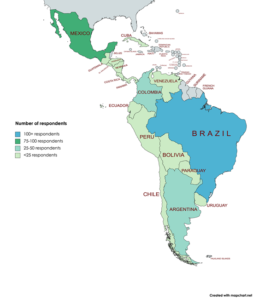 Figure 1. LATAM respondents’ self-reported country of residence
Figure 1. LATAM respondents’ self-reported country of residence